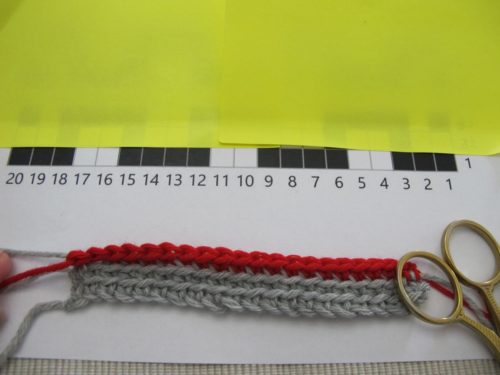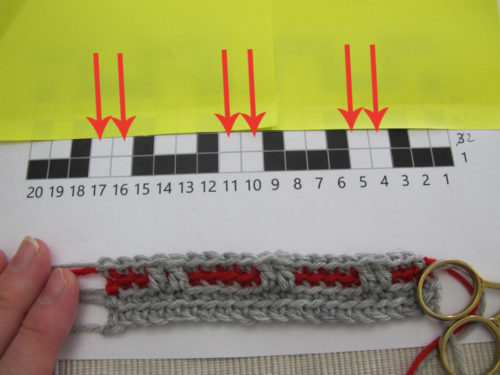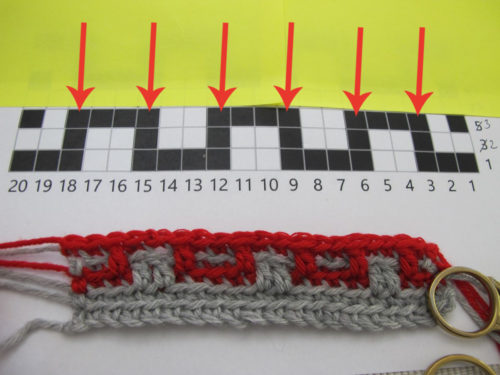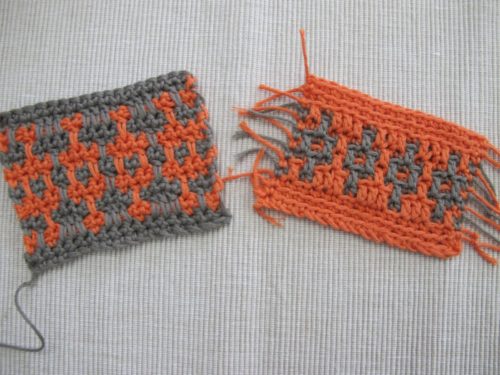In the shop

When you want to give a gift, big or small, but leave the choice to the recipient – you can now purchase gift vouchers in the shop!

I have received a new shipment of the laceweight mohair and silk yarn with more stock of the existing colours and a new, luscious one:
Click here to choose between all colours of mohair and silk in the shop.
Upcoming
I have been teaching crochet classes here locally in Lyon for over a decade now. But Lyon is a long way from many of you… Would you be interested in in-depth crochet classes online? Please tell me what you think in this survey (click to participate).
Mosaic crochet in the round/One-row mosaic crochet: reading charts.
I have been thinking about mosaic crochet for quite a while now. I have discussed the topic in my newsletters for January, March and April.
As we have previously seen, there are two different mosaic crochet techniques. Up to now, I called them “mosaic crochet worked flat” and “mosaic crochet in the round”. I wasn’t completely happy with these designations since the “flat” technique can be easily adapted to work in the round, and vice versa.
What seems to hold true on all occasions for these two techniques is that in the first case, the pattern is formed on two rows (or rounds), and in the second case, the pattern is formed on a single row (or round).
That’s why I think it might be more appropriate to talk about “two-row mosaic crochet” (instead of “mosaic crochet worked flat”) and “one-row mosaic crochet” (instead of “mosaic crochet in the round”). What do you think? Perhaps I’m the only one to geek out about this…
In any case, the
When studying this technique and, among others, Tinna Thórudóttir Thorvaldsdóttir’s beautiful patterns, I realized that the same charts can be used for both types of mosaic crochet. However, you need to read the chart in a different way – and the result will, of course, look different!
Let’s start with how to read the charts – you will see that you need to forget what you learned in the January newsletter, and use the chart in a different way.

This is the chart I chose to use for this tutorial. It’s one of the “practice charts” included in the newsletter for January, which means it was initially designed for two-row mosaic crochet.
The previous row numbers are no longer applicable. In the technique we are

To start my swatch I worked two rows of sc blo in the main colour.

Here I have worked the

From row 2 you will need to pay close attention to the chart and note the stitches in the active colour (here, the main colour) that are set on top of a stitch in the same colour in the previous row (see the stitches at the arrows in the photo). This indicates that you need to replace the sc
Note that all other stitches, independently of their colour in the chart, are worked as sc blo in the active colour.

On row 3 the rule is the same, except that the stitches to work as dc’s are, of course, in the contrasting colour, which is the active colour in this row.

We can observe that the pattern showing after each row is a “temporary” one – except after a one-colour row, like row 4 in this chart.

Since row 5 follows a one-colour row, it’s a row completely worked in sc



To complete the stitch pattern, we must consider that the row after row 7, which is not included in the chart, is a one-colour row in the main colour. You will need to work dc’s at the appropriate spots (see the arrows in the photo.)

I finish my swatch with another row in the main colour.
But if we can follow the same charts, which are the differences between the two techniques?

These two swatches were worked in organic cotton according to the same chart. The left swatch is worked in two-row mosaic crochet and the right swatch is worked in one-row mosaic crochet.
The one-row mosaic crochet gives a much more textured fabric. The dc’s creating the stitch pattern
There are also differences in the proportions and the presence of the different parts of the stitch pattern. The pattern is longer in two-row mosaic crochet, with lines that vary in thickness depending on whether they are created by
I expected the difference in height between the t
Which type of mosaic crochet should you choose for a given stitch pattern?
Part of the answer depends on your personal preference. Moreover, we must take into account not only the stitch pattern but also the project itself. The thickness, drape or sturdiness of the fabric will be determined both by the type of mosaic crochet used and the size of the hook.
From my point of view, since one-row mosaic crochet in all cases implies working all stitches on a row in the same colour, it seems interesting to use stitch patterns in which horizontal lines play an important part.

What do you think?
See you soon!


Hi. Thank you so much for the one row technique. I am a knitter and used Barbara Walker mosaic designs. Can they be converted to your crochet method?
Yes, you can!
I’m talking about exactly this here: https://englishblog.annettepetavy.com/2019/04/04/stitch-patterns-for-mosaic-crochet-sources-and-design-newsletter-march-2019/
Enjoy!
This was SUPER helpful! Thanks so much!!
I’m so glad!
Ty for making it look so easy appreciated